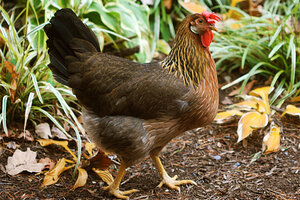Rescued hens flown across US. A new frontier for animal welfare?
A California egg factory had planned to gas aging birds, but after an animal rescue group stepped in, 1,150 hens traveled on an Embraer jet to the East Coast. From there, the birds will be placed in backyard chicken coops.

A laying hen strolls by a frost-damaged stand of hostas on a residential property near rural New Market, Va., November 3, 2008. Overnight Wednesday, 1,150 former commercial egg-laying hens traveled on an Embraer jet from California to the New York, believed to be the first transnational all-chicken flight in history.
Dean Fosdick/AP/File
Atlanta
Who says chickens don’t fly all that well?
Overnight Wednesday, 1,150 former commercial egg-laying hens flew pretty much first class – well, 10 to a crate – on an Embraer jet from California to New York, believed to be the first transnational all-chicken flight in history.
The flight came after an animal rescue group called Animal Place in Grass Valley, Calif., received the cluckers from a California egg factory, which had planned to gas the aging birds. An anonymous donor paid $43 a bird to have them shipped on a charter flight. The birds will be farmed out to backyard chicken coops in the Northeast and Midwest.
“It was a scary flight,” says Marji Beach, Animal Place’s education director. “It’s the first time we’ve done this. There was some turbulence, and the birds were definitely stressed out. But they arrived safe and sound in New York early this morning.”
The notion of near-flightless farm animals being saved and shuttled across the United States may mark a new chapter in the evolution of the animal rescue movement. The movement began, philosophically, with the fight to save spotted owls in the 1970s and later included dog rescue groups and no-kill animal shelters. Now, even ordinary farm animals, fish, snakes, and other “non-human beings” are being saved, primarily by animal welfare volunteers.
For traditionalists, it may all be going a bit far. In Alabama, for example, wildlife officials on Thursday banned wildlife rescuers from rehabilitating the injured creatures of seven species, including raccoons and possums. Animal lovers, the officials said, were interfering with natural cycles of life and death.
“It is our goal to hopefully educate the general public regarding the role of wildlife rehabilitation and the need to allow nature to act upon biological systems in an unbiased manner,” Jud Easterwood, a state wildlife supervisor, told WHNT News in Huntsville, Ala. “For example, it is more appropriate for a hawk to remove an injured/orphaned squirrel as opposed to preying on a healthy squirrel.”
But such sentiments have hardly stalled the animal welfare movement, which has seen a boost of support from growing awareness about conditions on corporate farms and in industrial slaughterhouses. The growth in the number of vegans and vegetarians in the US has also been a factor.
The rescue movement rose in visibility in the wake of the 2010 Gulf oil spill, when a small army of animal rescuers deployed to de-oil seabirds and sea turtles. Newspaper stories about animal welfare – whether it’s dolphin deaths in the Gulf or python rescues in the Everglades – tend to get high readership.
At the same time, redneck reality TV shows have begun to highlight divergent opinions about the place of animals in society and culture. Some shows such as “Swamp People” focus on harvesting animals like alligators, while others, including Ernie Brown Jr.’s “Call of the Wildman,” focus on humane rescues and releases.
Animal Place, which was founded in 1989, rescues, houses, and places a wide array of farm animals. In this case, the flock facing extinction numbered more than 3,000 birds. The group had planned to rescue 2,000, which is all the group could place in California and Oregon. When the situation was brought up to the eventual donor, the plan to fly the rest of the flock to the East Coast began to form.
According to a press release, “The hens were carefully loaded from Animal Place's two facilities in Grass Valley and Vacaville, CA, then trucked to the Hayward Executive Airport for a 6:45 p.m. departure. They arrived at Elmira Corning Regional Airport in Horseheads, NY around 7 a.m. after two stops for refueling.”
“This is the first time any group has flown this many birds across the country,” says Ms. Beach, noting a “kind of expansion of consciousness” happening around animal rescue and welfare.

